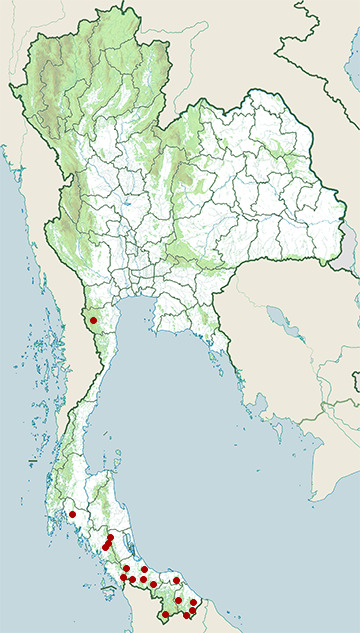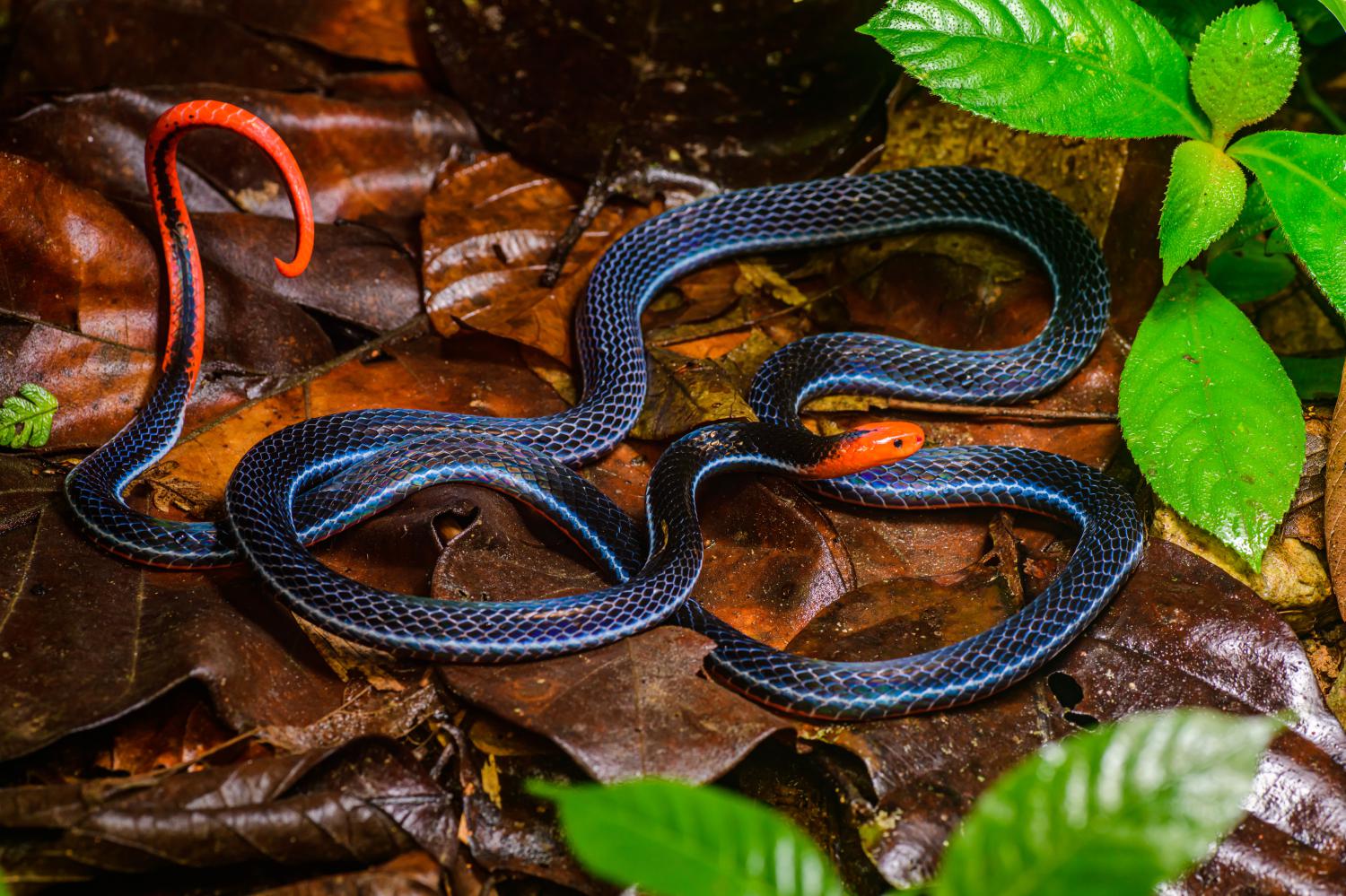Species of Thailand
Malaysian blue coral snake
Calliophis bivirgatus
(Heinrich Boie, 1827)
In Thai: งูพริกท้องแดง, ngu phrik thong daeng
Calliophis bivirgatus is a species of snake in the family Elapidae known commonly as the blue coral snake or blue Malayan coral snake. It is native to Southeast Asia.
Geographic range and distribution
This terrestrial snake occurs in Brunei, Indonesia, Malaysia, Singapore, Thailand, and Burma. It lives at 100 to 1100 meters in elevation.
There are three subspecies:
- C. b. bivirgatus – Indonesia
- C. b. flaviceps – Indonesia, Malaysia, Thailand, Singapore, Burma
- C. b. tetrataenia – Indonesia, Malaysia, Brunei
Description
This species was assigned to the new world coral snake genus Maticora until phylogenetic studies revealed this species to be nested within the tropical coral snake species clade Calliophis and sister species to Calliophis intestinalis, the banded Malaysian coral snake.
This is a medium-sized coral snake with a slender body. The adult can reach 1.8 meters long. It has a red head, tail and belly. The back is dark blue to black in color, and it usually has a large blue or white stripe on each flank.
The snake, especially when juvenile, is often confused with the pink-headed reed snake (Calamaria schlegeli) as they share similar habitat and appearance. But the latter is much smaller, reaching a maximum length of 50 cm. The reed snake is nonvenomous, while the coral snake is potentially lethal. They also are very similar to another venomous snake, the red-headed krait (Bungarus flaviceps).
Biology
This uncommon snake is considered semi-fossorial and is found in the leaf litter of primary and secondary forests. It preys on other snakes. When threatened it usually flees, but it may remain in place with its red tail erect as a defensive message.
Venom
Blue coral snake venom has only occasionally caused human deaths. This species has unusually long venom glands, extending to 25% of the length of the body. Unlike other snakes of the family Elapidae, its venom does not contain a neurotoxin. The toxic element is instead a unique cytotoxin called calliotoxin that causes near instantaneous paralysis by blocking the victims sodium channels. Phosphodiesterases promote the release of adenosine, which causes hypotension, inflammation, and neurotransmitter blockade in prey items and other bite victims. This ability is especially important as their prey consists mostly of other venomous snakes. There is no known antidote, though there is hope that the venom may eventually prove useful in the management of chronic pain in humans.
This article uses material from Wikipedia released under the Creative Commons Attribution-Share-Alike Licence 3.0. Eventual photos shown in this page may or may not be from Wikipedia, please see the license details for photos in photo by-lines.
Scientific classification
- Kingdom
- Animalia
- Phylum
- Chordata
- Subphylum
- Vertebrata
- Class
- Reptilia
- Order
- Squamata
- Suborder
- Serpentes
- Family
- Elapidae
- Genus
- Calliophis
- Species
- Calliophis bivirgatus
Common names
- German: Blaue Bauchdrüsenotter
- English:
- Blue Malaysian coral snake
- Blue long-glanded coral snake
- Thai: งูพริกท้องแดง, ngu phrik thong daeng
Subspecies
Calliophis bivirgata bivirgata, Friedrich Boie, 1827
Range: Indonesia (Java)
Calliophis bivirgata flaviceps, Theodore Edward Cantor, 1839
Range: South Thailand, W Malaysia, Singapore, Burma, Indonesia (fide Merel J. Cox et al.)
Calliophis bivirgata tetrataenia, Pieter Bleeker, 1859
Range: Indonesia (Kalimantan, Borneo); Brunei Darussalam; Malaysia (East Malaysia)
Conservation status

Least Concern (IUCN3.1)
Photos
Please help us review our species pages if wrong photos are used or any other details in the page is wrong. We can be reached via our contact us page.
Range Map

- Betong District, Yala
- Chana District, Songkhla
- Hala-Bala Wildlife Sanctuary
- Kaeng Krachan National Park
- Khao Chong
- Khao Phanom Bencha National Park
- Khao Pu - Khao Ya National Park
- Na Thawi District, Songkhla
- Saba Yoi District, Songkhla
- Sadao District, Songkhla
- Si Sakhon District, Narathiwat
- Su-ngai Padi District, Narathiwat
- Thale Ban National Park
- Thung Yang Daeng District, Pattani
- Ton Nga-Chang Wildlife Sanctuary
- Waeng District, Narathiwat
- Yan Ta Khao District, Trang

